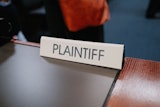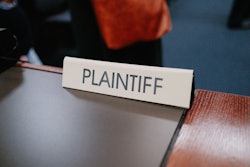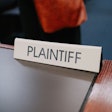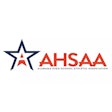The primary goal of every state high school athletic association is to develop rules and regulations that ensure fair and safe play.
The primary goal of every state high school athletic association is to develop rules and regulations that ensure fair and safe play. When high schools voluntarily join these associations, they agree to abide by the rules and regulations, and to allow the association to decide disagreements or eligibility questions. In fact, because joining these associations is voluntary, the only time the courts will intervene is when the actions of the association are found to violate constitutional law or public policy, or to have been enforced in an arbitrary or capricious manner.
Log in to view the full article
The primary goal of every state high school athletic association is to develop rules and regulations that ensure fair and safe play.
The primary goal of every state high school athletic association is to develop rules and regulations that ensure fair and safe play. When high schools voluntarily join these associations, they agree to abide by the rules and regulations, and to allow the association to decide disagreements or eligibility questions. In fact, because joining these associations is voluntary, the only time the courts will intervene is when the actions of the association are found to violate constitutional law or public policy, or to have been enforced in an arbitrary or capricious manner.
While, in general, being able to act without court interference in every decision that might have an adverse impact on some athlete or school is a good thing, there are times when judicial review would seem necessary to right an obvious wrong. One such case is Steven Adam Sisson v. Virginia High School League Inc. [2010 U.S. Dist. LEXIS 132264].
As a third grader, Steven Adam Sisson was diagnosed as having a learning disability. Even though his grades were good enough to pass him on to the fourth grade, Sisson's parents elected for him to repeat the third grade, based on the recommendation of his elementary school. Before his senior year at Eastern Montgomery High School in Montgomery County, Va., Sisson was informed that he would no longer be eligible to participate in sports because of his age. Under Virginia High School League eligibility rules, the so-called "age rule" prohibits a student from competing in high school athletics if he or she reaches the age of 19 on or before the first day of August of the school year in which he or she wishes to compete. Sisson turned 19 on July 31 and, therefore, was one day too old under the rule.
While the VHSL will waive the age rule in cases in which the athlete can show that he or she "experienced a delayed start or interruption in his/her educational progression due to a significant disability," Sisson's waiver request was denied by VHSL deputy director Tom Zimorski. Sisson did not have a significant disability, Zimorski ruled, since he was not mandated to repeat the third grade, but did so voluntarily. Sisson then appealed to an independent hearing officer, the final level of review under VHSL rules. Although the hearing officer found that Sisson's documented learning disability might fit one of the exceptions to the rule, the officer determined that being barred from participation was not an inequity or undue hardship.
After unsuccessfully attempting to obtain a waiver of the age rule, Sisson filed an action with the United States District Court for the Western District of Virginia under 42 U.S.C. § 1983, arguing that he was deprived of his due process and equal protection rights under the U.S. Constitution. Sisson sought a temporary restraining order allowing him to participate in VHSL interscholastic athletic programs and competitions.
In reviewing Sisson's motion, the district court held that in order to be granted injunctive relief, Sisson would have to establish: 1) that he would likely succeed on the merits of the case; 2) that he would likely suffer irreparable harm in the absence of preliminary relief; 3) that the balance of equities tipped in his favor; and 4) that an injunction was in the public interest. If he failed to establish all four of these requirements, the court held, a preliminary injunction would not be issued.
The court's conclusion was that Sisson failed to establish that he was entitled to injunctive relief because he was unlikely to succeed on the merits of his claims. In order to claim the procedural protections of the due-process clause of the Fourteenth Amendment, the court held that Sisson would have to establish that he had been deprived of life, liberty or property. While Sisson contended that he had a protected property interest in playing interscholastic athletics, the court held that while he may have had a property interest in a public education, students do not have a constitutionally protected interest in participating in interscholastic athletics. Therefore, the court concluded, Sisson's due-process claim had little to no likelihood of success.
As for Sisson's equal-protection claim, which was premised on the assertion that students like him are treated less favorably than foreign students who apply for waivers, the court found that it also had little to no likelihood of success. Sisson "must first demonstrate that he has been treated differently from others with whom he is similarly situated and that the unequal treatment was the result of intentional or purposeful discrimination," the court said, and if he were able to show unequal treatment, the court would then examine whether the disparity in treatment could be justified under the requisite level of scrutiny.
In finding that Sisson would be unable to satisfy either of the required elements, the court noted that VHSL eligibility decisions require an examination of facts and circumstances that are often unique to each student who applies for a waiver. Therefore, while it was undisputed that Sisson suffered from a learning disability, it was also undisputed that he was not required to repeat a grade as a result of his disability. Sisson's parents, the VHSL pointed out, elected for him to repeat third grade to improve his chances of academic success, even though his grades would have permitted him to be promoted to fourth grade. Given this distinguishing factor, the court held it would be difficult for Sisson to establish that he was similarly situated, in all relevant respects, to students who were granted waivers of the age requirement, or that the denial of his application was the result of purposeful discrimination.
Finally, the court was unable to conclude that Sisson would suffer irreparable harm in the absence of injunctive relief. In support of this finding, the court noted that other courts have rejected the notion that a student suffers irreparable harm by not being permitted to participate in interscholastic athletics. In this case, Sisson had the opportunity to play football, baseball and basketball for Eastern Montgomery during his first three years of high school, and it appeared from the record that he continued to associate with the school's athletic teams. Therefore, while it is understandable that he would have liked to compete during his final year of high school, it is difficult to conclude that he would be irreparably harmed if he were unable to do so.
While the district court may have been simply upholding the law, the real injustice with this case was the conduct of the VHSL. The main goals of age rules are to protect younger athletes from injury and to prevent redshirting for athletic purposes. In examining the facts of the case, there was no evidence that Steven Sisson posed a threat to other athletes on the field, and gaining a competitive advantage in high school was clearly not a part of his parents' decision-making process when Steven was in the third grade.
Based on those facts, and the fact that VHSL rules permit a student to apply for a waiver of the age rule if he or she experienced an interruption in his or her educational progression due to a significant disability, it is difficult to understand how preventing Sisson from competing in athletics his senior year because he was one day too old is fair or reasonable.
Legal Action
The National Swimming Pool Foundation has received settlement payments totaling $168,000 to resolve a copyright infringement lawsuit against the State of Nebraska and health departments of the Central District of Nebraska, Lincoln/Lancaster County and Douglas County. The departments were alleged to have lifted, without attribution, NSPF educational materials published between 1983 and 2007.
NSPF has announced an amnesty program to other health departments that may be improperly using NSPF materials. Departments that contact [email protected] prior to May 31 will not face legal action from the 501(c)(3) nonprofit. "The departments must agree to cease and desist from using NSPF materials and to work in good faith with NSPF to offer training consistent with the standard of care in our field," says Tom Lachocki, CEO of the NSPF.
In California, meanwhile, a $10,000 settlement has been reached between a San Diego boxing club and a group of U.S. Navy personnel who claimed they had been improperly charged membership dues. The plaintiffs had signed contracts with City Boxing with the understanding that they could either freeze their memberships or cancel them if they were deployed, but the club ultimately refused to stop billing them each month or refund the unused portion of their dues.
Under the terms of the judgment, former clients of City Boxing can request refunds for memberships canceled within the past four years by contacting the San Diego City Attorney's office at 619/533-5600.




































